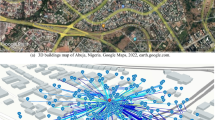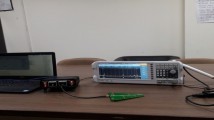Abstract
Given the disparity in signal transmission properties for both current bandwidths and millimeter wave radio frequencies, the present propagation models used for low frequency range up to few gigahertz are not suitable to be utilized for the path loss modelling techniques as well as modulation schemes for the high frequency ranges such as millimeter wave (mmWave) spectra. As a result, rigorous research on link analysis as well as path loss modeling are needed to create a broad and suitable transmission scheme with modeling variables that can handle a broad spectrum of mmWave frequency spectra. This paper proposes an improved path loss model for estimating the path loss in an indoor space wireless communication at 28 GHz and 38 GHz frequencies. The test results for the interior non-line-of-sight (NLOS) situations were collected every two meters over spacing of 24 m separating the transmitting and receiving antenna locations to make a comparison the well-known and improved large-scale generic path loss models. The results of the experimental studies obviously demonstrate that the improved propagation model works significantly better than the CI model, owing to its simple setup, precision, and accurate function. The results show that the presented improved model gives better performance. It is observed that the standard deviation of shadow fading can be significantly reduced in the NLOS scenario, implying greater accuracy in predicting the path loss in an indoor environment.










Similar content being viewed by others
Data availability
Not applicable.
References
Akyildiz, I. F., Han, C., & Nie, S. (2018). Combating the distance problem in the millimeter wave and terahertz frequency bands. IEEE Communications Magazine, 56(6), 102–108. https://doi.org/10.1109/MCOM.2018.1700928
Oladimeji, T., Kumar, P., & Elmezughi, M. K. (2022). Path loss measurements and model analysis in an indoor corridor environment at 28 and 38 GHz. Sensors, 22(19), 1–33. https://doi.org/10.3390/s22197642
Gui, J., Dai, X., & Deng, X. (2020). Stabilizing transmission capacity in millimeter wave links by Q-learning-based scheme. Hindawi Mobile Information Systems, 2020, 1–17. https://doi.org/10.1155/2020/7607316
Ahmed, B. T., Masa Campos, J. L., & Lalueza Mayordomo, J. M. (2012). Propagation path loss and materials insertion loss in indoor environment at WiMAX band of 3.3 to 3.6 GHz. Wireless Personal Communications, 66, 251–260. https://doi.org/10.1007/s11277-011-0335-2
Swain, C. M. K., & Das, S. (2021). proposed prediction framework for improving the accuracy of path loss models of WiMAX network. Wireless Personal Communications, 117, 1079–1101. https://doi.org/10.1007/s11277-020-07912-z
Gupta, A., & Jha, R. K. (2015). A survey of 5G network: Architecture and emerging technologies. IEEE Access, 3, 1206–1232. https://doi.org/10.1109/ACCESS.2015.2461602
Oladimeji, T. T., & KumarOyie, P. N. O. (2022). propagation path loss prediction modelling in enclosed environments for 5G networks: A review. Heliyon, 8, 1–16. https://doi.org/10.1016/j.heliyon.2022.e11581
Al-Samman, A. M., Azmi, M. H., Al-Gumaei, Y. A., Al-Hadhrami, T., Rahman, T. A., Fazea, Y., & Al-Mqdashi, A. (2020). Millimetre wave propagation measurements and characteristics for 5G system. Applied Sciences, 10(335), 1–17. https://doi.org/10.3390/app10010335
Al-Gumaei, Y. A., Aslam, N., Al-Samman, A. M., Al-Hadhrami, T., Noordin, K., & Fazea, Y. (2019). Non-cooperative power control game in D2D underlying networks with variant system conditions. Electronics, 8(10), 1–15. https://doi.org/10.3390/electronics8101113
Pi, Z., & Khan, F. (2011). An introduction to millimeter wave mobile broadband systems. IEEE Communications Magizne, 49, 101–107. https://doi.org/10.1109/MCOM.2011.5783993
Rappaport, T. S., MacCartney, G. R., & SamimiSun, M. K. S. (2015). Wideband millimeter waves propagation measurements and channel models for future wireless communication system design. IEEE Transactions Communications, 63, 3029–3056. https://doi.org/10.1109/TCOMM.2015.2434384
Lin, Z., Du, X., Chen, H., Ai, B., Chen, Z., & Wu, D. (2019). Millimeter wave propagation modelling and measurements for 5G mobile network. IEEE Wireless Communications, 26(1), 72–77. https://doi.org/10.1109/MWC.2019.1800035
Tataria, H., Haneda, K., Molisch, A. F., & ShafiTufvesson, M. F. (2021). Standardization of propagation models: 800 MHz to 100 GHz a historical perspective. International Journal of Wireless Information Networks, 28(1), 1–25. https://doi.org/10.1007/s10776-020-00500-9
3GPP TR 36.104. (2019). Technical specification of radio access network: Base station radio transmission and reception
Molisch, A. F. (2011). Wireless Communications (2nd ed.). USA: Wiley.
Steele, R. (1992). 1992. Pentech Press.
Shafi, M., Tataria, H., Molisch, A.F., Tufvesson, F., & Tunnicliffe, G. (2020). Real-time deployment aspects of c-band and millimeter-wave 5G-NR systems. ICC 2020–2020 IEEE international conference on communications (ICC), 1–7. Doi: https://doi.org/10.1109/ICC40277.2020.9148902
ITU-R M.1225, (1997) Guidelines for evaluation of radio transmission, ITUR
Stefanovic, M., Panic, S. R., Souza, R. A. A., & Reig, J. (2017). Recent advances in RF propagation modelling for 5G systems. Hindawi International Journal of Antennas and Propagation, 2017, 1–5. https://doi.org/10.1155/2017/4701208
Oyie, N. O., & Afullo, T. J. O. (2018). Measurements and analysis of large scale path loss model at 14 and 22 GHz in indoor corridor. IEEE Access, 6, 17205–17214. https://doi.org/10.1109/ACCESS.2018.2802038
Document RP 151306, 3GPP. (2015). Channel modelling for higher frequency bands
METIS Deliverables D1.2. (2017). Initial channel models based on measurements. Accessed November 5, 2017
Moraitis, N., & Constantinou, P. (2014). indoor channel measurements and characterization at 60 GHz for wireless local area network applications. IEEE Transactions on Antennas and Propagation, 52(12), 3180–3189. https://doi.org/10.1109/TAP.2004.836422
Elmezughi, M. K., Salih, O., Afullo, T. J., & Duffy, K. J. (2022). Comparative analysis of major machine-learning based path loss models for enclosed indoor channels. Sensors, 22(13), 1–25. https://doi.org/10.3390/s22134967
Nguyen, C., & Cheema, A. A. (2021). A deep neural network-based multi-frequency path loss prediction model from 0.8 GHz to 70 GHz. Sensors, 21(15), 1–24. https://doi.org/10.3390/s21155100
Faruk, N., Popoola, S. I., Surajudeen-Bakinde, N. T., Oloyede, A. A., Abdulkarim, A., Olawoyin, L. A., Ali, M., Calafate, C. T., & Atayero, A. A. (2019). Path loss predictions in the VHF and UHF bands within urban environments: Experimental investigation of empirical. Heuristics and Geospatial Models IEEE Access, 7, 77293–77307. https://doi.org/10.1109/ACCESS.2019.2921411
Jo, H. S., Park, C., Lee, E., Choi, H. K., & Park, J. (2020). Path loss prediction based on machine learning techniques: Principal component analysis, artificial neural network and gaussian process. Sensors, 20(7), 1–23. https://doi.org/10.3390/s20071927
Majed, M. B., Rahman, T. A., Aziz, O. A., Hindia, M. N., & Hanafi, E. (2018). Channel characterization and path loss modeling in indoor environment at 4.5, 28, and 38 GHz for 5G cellular networks. International Journal of Antennas and Propagation, 2018, 1–14. https://doi.org/10.1155/2018/9142367
Al-Saman, A., Cheffena, M., Elijah, O., Al-Gumaei, Y. A., Abdul Rahim, S. K., & Al-Hadhrami, T. (2021). Survey of millimeter-wave propagation measurements and models in indoor environments. Electronics, 10(14), 1–28. https://doi.org/10.3390/electronics10141653
Khatun, M., Guo, C., Moro, L., Matolak, D., & Mehrpouyan, H. (2019). Millimeter-wave path loss at 73 GHz in indoor and outdoor airport environments. 2019 IEEE 90th vehicular technology conference (VTC2019-Fall), 1–5. Doi: https://doi.org/10.1109/VTCFall.2019.8891488
Cheng, C., Kim, S., & Zajić, A. (2017). Comparison of path loss models for indoor 30 GHz, 140 GHz, and 300 GHz channels. 2017 11th European conference on antennas and propagation (EUCAP), 716–720. Doi: https://doi.org/10.23919/EuCAP.2017.7928124
Beauvarlet, D., & Virga, K. L. (2002). Measured characteristics of 30-GHz indoor propagation channels with low-profile directional antennas. IEEE Antennas and Wireless Propagation Letters, 1(1), 87–90. https://doi.org/10.1109/LAWP.2002.802553
Sulyman, A. I., Nassar, A. T., Samimi, M. K., MacCartney, G. R., Rappaport, T. S., & Alsanie, A. (2014). Radio propagation path loss models for 5G cellular networks in the 28 GHz and 38 GHz millimeter-wave bands. Communications Magazine IEEE, 52(9), 78–86. https://doi.org/10.1109/MCOM.2015.7010549
Oladimeji, T. T., Kumar, P., & Elmezughi, M. K. (2023). Performance analysis of improved path loss models for millimeter-wave wireless network channels at 28 GHz and 38 GHz. PLoS ONE, 18, 1–27. https://doi.org/10.1371/journal.pone.0283005
Rappaport, T. S., Xing, Y., Maccartney, G. R., & Molisch, A. F. (2017). Overview of millimeter wave communications for a focus on propagation models. IEEE Transactions on antennas and propagation, 65, 6213–6230.
Talib, M., Aripin, N. B. M., Othman, N. S. & Sallomi, A. H. (2022). Comprehensive overview on millimeter wave communications for 5G networks concentrating on propagation models for different urban environments. 3rd international conference on mathematics and applied science (ICMAS 2022). Doi: https://doi.org/10.1088/1742-6596/2322/1/012095
Maccartney, G. R., Samimi, M. K., & Rappaport, T. S. (2015). Exploiting directionality for millimeter-wave wireless system improvement. 2015 IEEE international conference on communications (ICC), London, pp 2416–2422. Doi: https://doi.org/10.1109/ICC.2015.7248687
HurChoLeeKangParkBenn, S. Y. J. N. J. H. (2014). Synchronous channel sounder using horn antenna and indoor measurements on 28 GHz. IEEE International Black Sea Conference on Communications and Networking (BlackSeaCom), 2014, 83–87. https://doi.org/10.1109/BlackSeaCom.2014.6849010
Rappaport, T. S., Maccartney, G. R., & SunYanDeng, S. H. S. (2017). Small-Scale, local area, and transitional millimeter wave propagation for 5G communications. IEEE Transactions on Antennas and Propagation, 65, 6474–6490. https://doi.org/10.1109/TAP.2017.2734159
DengMaccartneyRappaport, S. G. R. S. T. S. (2016). Indoor and outdoor 5G diffraction measurements and models at 10, 20, and 26 GHz. IEEE Global Communications Conference (GLOBECOM), 2016, 1–7. https://doi.org/10.1109/GLOCOM.2016.7841898
Sun, S., et al. (2016). Investigation of prediction accuracy, sensitivity, and parameter stability of large scale propagation path loss models for 5G wireless communications. IEEE Transactions Vehicular Technology, 65, 2843–2860.
Samimi, M. K., Rappaport, T. S., & Maccartney, G. R. (2015). Probabilistic omnidirectional path loss models for millimeter-wave outdoor communications. IEEE Wireless Communications Letters, 4, 357–360.
Oladimeji, T., Kumar, P., & Elmezughi, M. (2023). Performance analysis of high order close-in path loss model at 28 and 38 GHz. 2023 conference on information communications technology and society (ICTAS 2023), 1–5. Doi: https://doi.org/10.1109/ICTAS56421.2023.10082746
Huang, J. I. E., Cao, Y., Raimundo, X., & Cheema, A. (2019). Rain statistics investigation and rain attenuation modeling for millimeter wave short-range fixed links. IEEE Access, 7, 156110–156120. https://doi.org/10.1109/ACCESS.2019.2949437
He, R., Gong, Y., Bai, W., Li, Y., & Wang, X. (2020). Random forests based path loss prediction in mobile communication systems. Proceedings of the 2020 IEEE 6th international conference on computer and communications (ICCC), 3029–3056. Doi: https://doi.org/10.1109/ICCC51575.2020.9344905
Faizan, Q. (2020). Enhancing QOS performance of the 5G network by characterizing mm-wave channel and optimizing interference cancellation scheme. A thesis submitted for doctor of philosophy, University of Malaya
Thomas. T.A. et al., (2016). A prediction study of path loss models from 2–73.5 GHz in an urban-macro environment. Proccedings IEEE 83rd VTC Spring, 1–5. Doi: https://doi.org/10.1109/VTCSpring.2016.7504094
Schilcher, U., Toumpis, S., Haenggi, M., Crismani, A., Brandner, G., & Bettstetter, C. (2016). Interference functionals in poisson networks. IEEE Transactions On Information Theory, 62(1), 371–384. https://doi.org/10.1109/TIT.2015.2501799
Sun, S. et al. (2016). Propagation path loss models for 5G urban micro- and macro-cellular scenarios. Proccedings IEEE 83rd VTC Spring, 1–6. Doi: https://doi.org/10.1109/VTCSpring.2016.7504435
Sun.S., MacCartney Jr. G. R., and Rappaport. T. S. (2016). Millimeter-wave distance-dependent large-scale propagation measurements and path loss models for outdoor and indoor 5G systems. Proccedings 10th EuCAP, 1–5. Doi: https://doi.org/10.1109/EuCAP.2016.7481506
Elmezughi M. K., Afullo. T. J., and Oyie N. O, (2020). Investigating the Impact of Antenna Heights on Path Loss Models in an Indoor Corridor Environment. icABCD 2020 Conference IEEE, pp 1–7. Doi: https://doi.org/10.1109/icABCD49160.2020.9183859
Funding
The authors declare that no funds, grants, or other support were received during the preparation of this manuscript.
Author information
Authors and Affiliations
Contributions
Conceptualization, TO; Methodology, TO, PK and ME; Formal Analysis, TO and ME; Measurements, TO; Writing—Original Draft Preparation, TO; Writing, Review and Editing, PK; Supervision, PK; Project Administration, PK. All authors have read and agreed to the published version of the manuscript.
Corresponding author
Ethics declarations
Conflict interest
The authors have no relevant financial or non-financial interests to disclose.
Additional information
Publisher's Note
Springer Nature remains neutral with regard to jurisdictional claims in published maps and institutional affiliations.
Rights and permissions
Springer Nature or its licensor (e.g. a society or other partner) holds exclusive rights to this article under a publishing agreement with the author(s) or other rightsholder(s); author self-archiving of the accepted manuscript version of this article is solely governed by the terms of such publishing agreement and applicable law.
About this article
Cite this article
Oladimeji, T.T., Kumar, P. & Elmezughi, M. An improved path loss model for 5G wireless networks in an enclosed hallway. Wireless Netw 30, 2353–2364 (2024). https://doi.org/10.1007/s11276-024-03675-8
Accepted:
Published:
Issue Date:
DOI: https://doi.org/10.1007/s11276-024-03675-8




